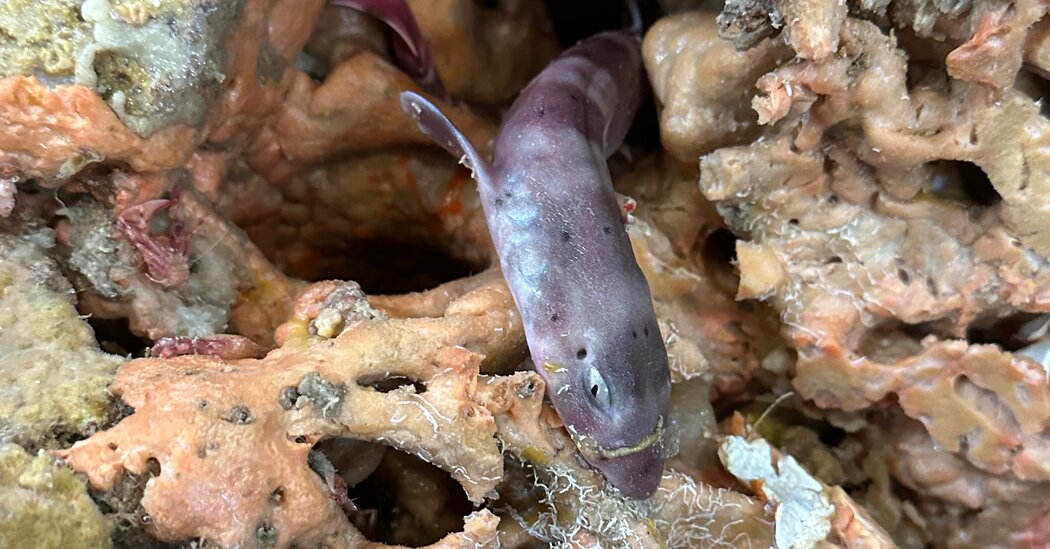

John Pogonoski, an ichthyologist in Australia, wasn’t about to be fooled by any moray eels. He knew the serpentine fish like to hide among the nooks and crannies of large sponges. But as he surveyed sponges collected from a remote seabed off the coast of Western Australia, he stumbled on a complete surprise — a small shark tail poking out of a sponge’s cavernous body.
The errant tail belonged to Atelomycterus fasciatus, better known as a banded sand catshark. And it wasn’t alone. Mr. Pogonoski, who works at the Commonwealth Scientific and Industrial Research Organization, or CSIRO, and colleagues found as many as 30 of the petite predators packed into just one sponge. The discovery, reported in the Journal of Fish Biology, is the first record of any shark using the inside of a sponge as a habitat.
“We see sharks in small caves, we see sharks hiding within crevices in coral reefs,” said David Shiffman, a shark biologist and faculty research associate at Arizona State University who was not involved in the study. “Sponges, though, this is new.”
The word “shark” may conjure images of gargantuan great whites or hefty hammerheads. But the cartilaginous carnivores come in many sizes. The banded sand catshark, maxing out around a foot and a half in length, is on the smaller end of the spectrum.
“This small size makes them quite vulnerable to predation by larger sharks and fish,” said Helen O’Neill, a fish biologist at CSIRO’s Australian National Fish Collection in Tasmania and an author of the paper. At night the catsharks prowl the seafloor for prey, but Ms. O’Neill suspects that during the day “they are hiding safely within the sponges” to avoid becoming food themselves.
The sponge-burrowing turned out to be a popular activity. After Mr. Pogonoski’s fortuitous find, the researchers ultimately discovered 57 catsharks in two kinds of sponge. The sharks were male, female, young, old; hiding in sponges seems to be fun the whole family can enjoy. Because other shark species are known to lay their eggs on the outside of sponges, Dr. Shiffman said it’s possible the catsharks are using the porous, living dwellings to raise their families. “Animals are always looking for ways to protect their babies,” he said.
Another question is whether the sponges get anything in return by renting space to the sharks.
“More investigation would be needed to assess whether the sponge would benefit from the sharks’ presence,” Ms. O’Neill said. She theorizes that the sharks could potentially be eating small fish or invertebrates that would otherwise snack on the sponge. “Security guard for the hotel,” she said with a wink.
This was an opportunistic observation, so much remains unknown about what the sharks are doing inside the sponges and why. “No one was observing the sharks go into there, or how long they’re in there, or what they’re doing,” Dr. Shiffman said. The unexpected nature of this discovery also means that there’s no follow-up work currently planned, Ms. O’Neill said, but “we will certainly be keeping our eyes peeled on future voyages.”
There are more than 530 species of shark, many as small as the banded sand catshark, so it’s likely that others are spending time inside sponges, too. And given how poorly understood the banded sand catshark is, who knows what else it — and other species — could be getting up to.
“Sharks are not a one-dimensional thing,” Dr. Shiffman said. “They come in every shape and size and color that you can imagine. They have all sorts of weird behaviors, and we’re still learning new things about them.”
24World Media does not take any responsibility of the information you see on this page. The content this page contains is from independent third-party content provider. If you have any concerns regarding the content, please free to write us here: contact@24worldmedia.com

Common Mistakes When Using Athletic Field Tarps

High-Performance Diesel Truck Upgrades You Should Consider

Warehouse Optimization Tips To Improve Performance

Fire Hazards in Daily Life: The Most Common Ignition Sources

Yellowstone’s Wolves: A Debate Over Their Role in the Park’s Ecosystem

Earth Day 2024: A Look at 3 Places Adapting Quickly to Fight Climate Change

Millions of Girls in Africa Will Miss HPV Shots After Merck Production Problem

This Lava Tube in Saudi Arabia Has Been a Human Refuge for 7,000 Years

Four Wild Ways to Save the Koala (That Just Might Work)

National Academy Asks Court to Strip Sackler Name From Endowment

Ways Industrial Copper Helps Energy Production

The Ins and Out of Industrial Conveyor Belts